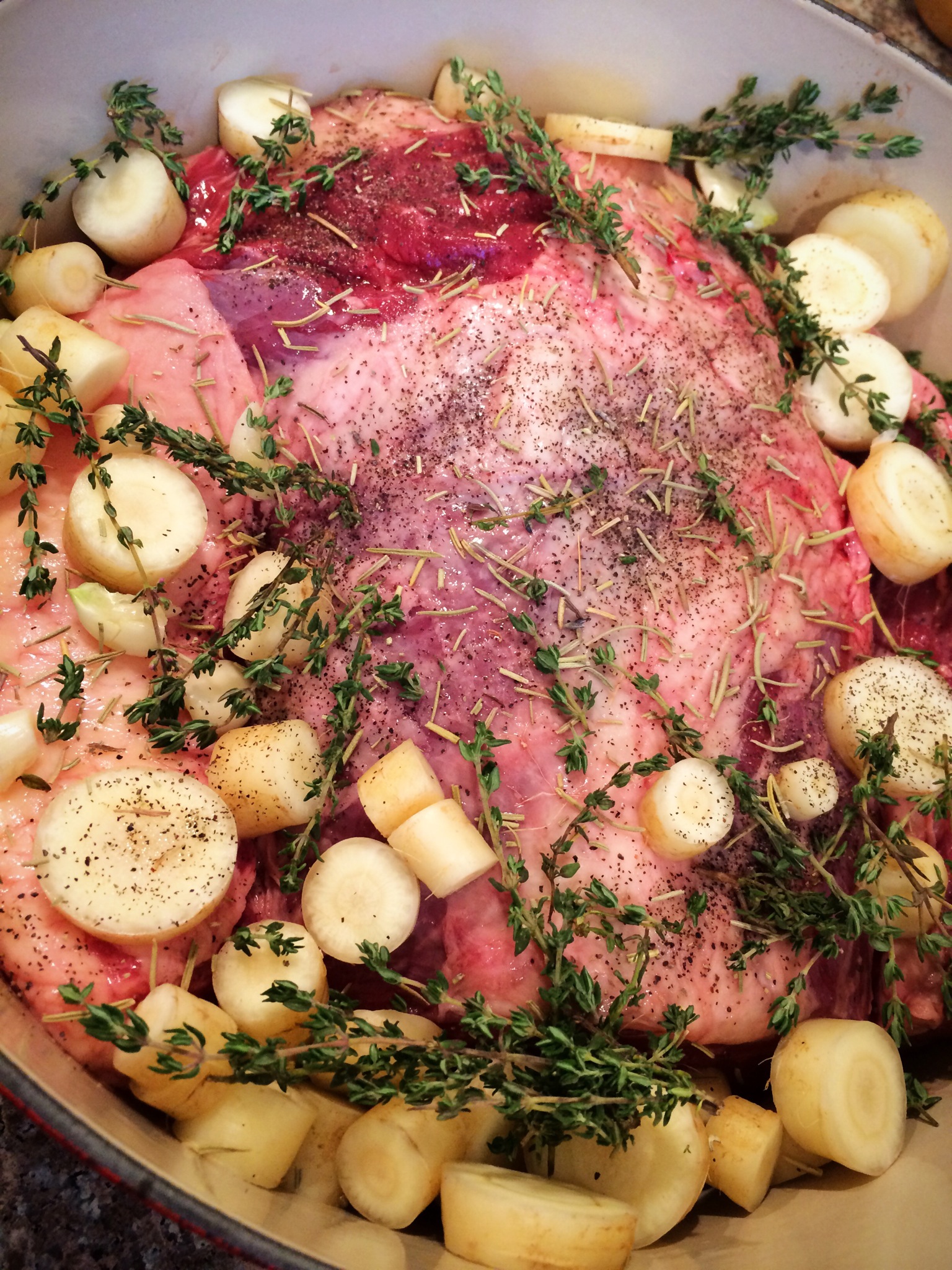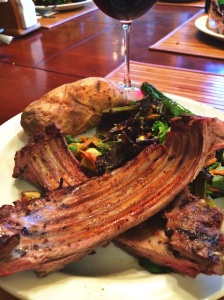In my daily nutrition geek-out session, I came across THIS article, and it really hit home for me. I am adamant about buying and eating only sustainably raised, 100% grass fed meat, pastured poultry and pork, and wild caught fish (sometimes annoyingly so). But there is good reason for this beyond just that it tastes amazing (especially with the marinade I give you at the end of this post). Initially, it stemmed from the same reasons I chose vegetarianism for so many years. The treatment of cows in unsanitary feedlots across the country, chickens with breasts so large they literally cannot walk, animals that are fed diets of feed that I wouldn’t consider eating in a million years (and really shouldn’t be called “feed” at all); the animal rights activists and vegans are on to something in their disdain for meat eaters and factory farming, but this is only the case when we look at conventional feed lots across the country. When we take a look at small farms with properly raised animals that eat, live, poop, and roam as they should, the outcome and resulting symbiotic relationship is very different. When we eat these properly raised animals (and all parts of them, including organ meats, bones, marrow, etc.), we are fulfilling a natural order, fueling our bodies with incredible nutrients, and supporting small farmers who are going against the grain (literally) to raise their animals with care and respect. That respect comes full circle as the animals that have had a good life of food, protection, room to roam, and plenty of sunshine then provide precious necessary nutrients and a source of income.
The classic idiom “you are what you eat” applies just as well to cows as it does to humans, and there are some pretty significant differences in the quality of red meat based on how the animal was fed.
Now, in many (albeit not all) grain fed lots, the animals are not only treated poorly, but once those animals become food, they definitely don’t pack the nutritional punch that their properly raised, happy, grass fed, pastured counterparts do. 4 years ago, upon realizing that if I didn’t eat meat my health would deteriorate and I would probably never be able to have kids in the future, I knew something had to change, but I wasn’t willing to just eat meat blindly and put all of my beliefs behind me. So, I set out to research like crazy, to be my own experiment, and to find out what true health meant for me. This has inspired my nutrition work and my passion for eating and creating the most nutritionally dense food possible. This brings me back to the the previously mentioned article and my point. In his post, Chris Kresser dives into the science behind the arguments for eating grass fed over grain fed red meat, eloquently portraying just one more solid argument in favor of eating animals that have been raised properly.
If the ethical reasons for eating grass fed animals doesn’t sway you or your loved ones, perhaps the nutritional reasons will be the bump needed to see the light.
You can find Kresser’s article, “Why Grass-Fed Trumps Grain-Fed”, HERE, but I thought I would sum up my favorite points for you:
Fatty Acid Composition:
Within the broad categories of saturated fatty acids (SFA), monounsaturated fatty acids (MUFA), and polyunsaturated fatty acids (PUFA), there are several individual fatty acids with different chemical compositions, and each has unique effects on the body.
Omega-3 and Omega-6 (PUFAS):
There are significantly higher levels of omega-3s found in grass-fed beef.
2 to 5 times more omega-3s than grain-fed beef, actually. The average diet provides a huge imbalance of far too many omega 6s to omega 3s, but that average ratio in grass fed beef is 1.53:1, while it’s counterpart contains a ration of 7.65:1.
Saturated Fat
There are three main types of saturated fat found in red meat: stearic acid, palmitic acid, and myristic acid. Grass-fed beef consistently contains a higher proportion of stearic acid, which does not raise blood cholesterol levels. Plus, the higher levels of this saturated fat means lower levels of the other two.
Conjugated Linoleic Acid
Conjugated linoleic acid (CLA) is a type of PUFA that exhibits potent antioxidant activity, and might be protective against heart disease, diabetes, and cancer. Fortunately, beef is one of the best dietary sources of CLA.
Grass-fed beef contains an average of 2 to 3 times more CLA than grain-fed beef.
Grain-based diets reduce the pH of the digestive system, inhibiting the growth of the bacterium that produces CLA.
Antioxidants, Vitamins and Minerals
Grass fed meat also contains more antioxidants, vitamins, and minerals. Let’s take carotenoids for example. The beta-carotene, a precursor to vitamin A) found in carotenoid-rich grass and forage incorporate significant amounts of these compounds into their tissues, making the beautiful yellow color of grass fed butter.
Grass-fed beef also has more of the antioxidants vitamin E, glutathione, superoxide dismutase (SOD), and catalase which play an important role in protecting our cells from oxidation, especially delicate fats in the cell membrane such as omega-3 and omega-6, and in protecting the meat from damage during the journey from butcher to plate.
Grass-fed beef also contains higher levels of the beneficial nutrients zinc, iron, phosphorus, sodium, and potassium.
Sure it might be a little more costly, but think of the benefits to your health, and consider the small farmer who is going against the grain to treat his animals humanely, feed them as nature intended, and bring you nutrient dense, essential food.
Beef is a great option, but you can get the same benefits from grass fed lamb and bison. Yum! Just some FOOD for thought!
And now, an easy marinade to help make this nutritious, grass fed, meaty goodness the star of any meal, the anytime, any place, any meat marinade! Check out this picture of some wild boar my dad hunted and killed last week. The marinade was AWESOME on these ribs. The whole family loved it. My dad even said they were “the best ribs he’s ever had” and they weren’t fattened on corn or grain. Imagine that….
Anytime, Any Meat Marinade
WHAT YOU NEED:
- 2 lbs of meat* (increase or decrease other ingredients proportionately to amount of meat)
- 3 tbsp of olive oil or ghee
- 3 tbsp apple cider vinegar
- 3 tbsp stone ground mustard (I like the Sir Kensington’s Spicy Brown)
- 3 tbsp coconut aminos
- 2 tbsp minced garlic
- sea salt and ground black pepper
*I’ve used this for wild boar, grass fed steaks, and even as a sauce to dip ribs in (pretty amazing).
WHAT YOU DO:
- mix your ingredients well in a bowl
- either marinate for up to 6 hours or simply pour desired amount evenly over your meat
- grill, roast, pan sear… whatever your heart desires!
- keep some on the side for dipping, and feel free to lick the bowl!
Enjoy! Let me know if you make this and what you think. Have a great weekend everyone, and enjoy a nice steak with the family! Remember to always keep educating yourself, reading, searching, and doing whatever makes you feel your best and happiest. For me, that includes plenty of grass fed meat and butter. Cheers!







[…] Creating foods from animals that are loaded with higher levels of omega-3 fatty acids, which are better for both cardiovascular HEALTH and contain anti-inflammatory properties and have significantly higher values of vitamins A and E as well as antioxidants (more on why pastured red meat is so nourishing HERE). […]